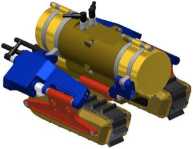7696081857
10 Diagnostyka - Applied Structural Health, Usage and Condition Monitoring’ 3(63)/2012 CISZEWSKI, BURATOWSKI, GIERGIEL, KURC, AUŁKA, The PipesMobile Inspection Robots
Robots for operation in yentilation ducts are mainly designed with focus on cleaning tasks. Wang and Zhang [16] propose a tracked platform with guiding wheel that can host interchangeable brushes, intended for cleaning of horizontal ducts.
Market research for inspection robots revealed several Solutions. Inuktun produces a wide rangę of tracked inspection robots. Versatrax models are available in three different sizes for minimal pipę diaineters: 100, 150 and 300 mm [10], Their main components are individually operated tracks of different sizes. Manually adjustable chassis allows adapting of the robot to sewer and storm drains, air ducts, tanks, oil and gas pipelines, pulp and paper industry. Versatrax Vertical is a three-track version for vertical, diy pipę inspection [9], iPEK produces wheeled inspection vehicles. ROWER for pipes with diameter 100-300, 150-760 and 230-1520 mm [11], These robots have modular design, with replaceable wheels, suitable for horizontal pipes and operation up to 10 m underwater. Solo robot by RedZone is a tracked, wireless, autonomous robot that can be used in horizontal pipes ranging from 200-300 imn diameter [13], CUES offer tracked inspection robots for pipes with diameter from 150 to 760 mm. Their main feature is narrow track madę of large segments. [5],
As we may observe, numerous Solutions for inspection robots are available. Wheels provide tlie least rolling resistance and are energy efficient, however smali contact surface may not be sufficient for some uneven surfaces. Crawling motion lias speed limitations and especially upper limit of pipę or duet dimension is a major drawback. As presented by the market research, numerous Solutions utilizing track drive have been developed. Tracks provide proper obstacle passing capabilities and considerably large contact is advantageous in terms of friction. The presented tracked robots, do not possess online track positioning and are designed for specific purposes. This paper presents a design of a versatile tracked mobile robot with an adaptive track positioning system intended for video inspection.
1. MECHANICAL STRUCTURE
Similarly to most of the analyzed robot structures, it was decided to utilize two tracks. That configuration will ensure proper robot stability and maneuverability, assuining that the robot will consist of one segment. For this project, Inuktun Microtrac track modules with diinensions 60x50x170 mm will be utilized. They are designed specifically for pipę inspection, with focus on smali inspection platfonns.
For creating the virtual prototype of the inspection robot, Autodesk Imentor Professional 2012 was used.
Track positioning system consists of two independently rotating rings, with a centre of rotation in the axis of the robot body. To each of these rings, an ann is attached on a rotaiy joint. These anns are similarly mounted to both sides of each track. This configuration allows various orientations of track with respect to the robot body. Each track unit is adjusted by tliree drives. Two drives allow rotation of rings in the robot body axis and the tliird drive positions one arm with respect to tlie track. Drives selected for the rotating rings are digital senoinotors Hitec HS-7950TH that possess high holding torąue, compact size and integrated position controller. The rotating rings are coimected with robot outer and iimer arms. The generał view of the robot is presented in the Fig. 1. Drive controllers and power electronics are located inside tlie robot body as depicted in Fig. 2.
In total, the robot has 8 drives: 2 tracks and 6 track positioning sen omotors and consists of over 230 components. among which over 60 have to be manufactured. The total weight of the robot is 6.9 kg, where the weight of one stainless Steel track is 2 kg. The total weight does not include camera, lighting and cables. Components such as robot body. anns, ring spacers, cups and track mounts. The robot is capable of operation in liquid enviromnent such as w ater, sewage or oil. In order to meet this reąuirement, coimections are sealed and cables are routed with usage of waterproof comiectors.

Fig. 1. Robot model - generał view

Fig. 2. Controller compartment
Wyszukiwarka
Podobne podstrony:
12 Diagnostyka - Applied Structural Health, Usage and Condition Monitoring 3(63)/2012 CISZEWSKI, BU
14 Diagnostyka - Applied Structural Health, Usage and Condition Monitoring 3(63)/2012 CISZEWSKI, BU
Diagnostyka - Applied Structural Health, Usage and Condition Monitoring’ 3(63)/2012 Cholewa, Amarowi
Diagnostyka - Applied Structural Health, Usage and Condition Monitoring’ 3(63)/2012
Diagnostyka - Applied Structural Health, Usage and Condition Monitoring’ 3(63)/2012
Diagnostyka - Applied Structural Health, Usage and Condition Monitoring 3(63)/2012
Diagnostyka - Applied Structural Health, Usage and Condition Monitoring’ 3(63)/2012
Diagnostyka - Applied Structural Health, Usage and Condition Monitoring 3(63)/2012
Diagnostyka - Applied Structural Health, Usage and Condition Monitoring 3(63)/2012 Spis treści /
Diagnostyka - Applied Structural Health, Usage and Condition Monitoring 3(63)/2012 Cholewa, Amarowi
Diagnostyka - Applied Structural Health, Usage and Condition Monitoring 3(63)/2012 Cholewa, Amarowi
Diagnostyka - Applied Structural Health, Usage and Condition Monitoring 3(63)/2012 Cholewa, Amarowi
Diagnostyka - Applied Structural Health, Usage and Condition Monitoring 3(63)/2012 Cholewa, Amarowi
Diagnostyka - Applied Structural Health, Usage and Condition Monitoring’ 3(63)/2012 Cholewa, Amarowi
18 Diagnostyka - Applied Structural Health, Usage and Condition Monitoring 2(62)/2012 Charchalis, D
10 Diagnostyka - Diagnostics and Structural Health Monitoring 1(57)/2011 GONTARZ,
8 Diagnostyka - Diagnostics and Structural Health Monitoring l(57)/2011 GONTARZ,
Diagnostyka - Diagnostics and Structural Health Monitoring l(57)/2011 9 GONTARZ,
Diagnostyka - Diagnostics and Structural Health Monitoring l(57)/2011 11 GONTARZ,
więcej podobnych podstron